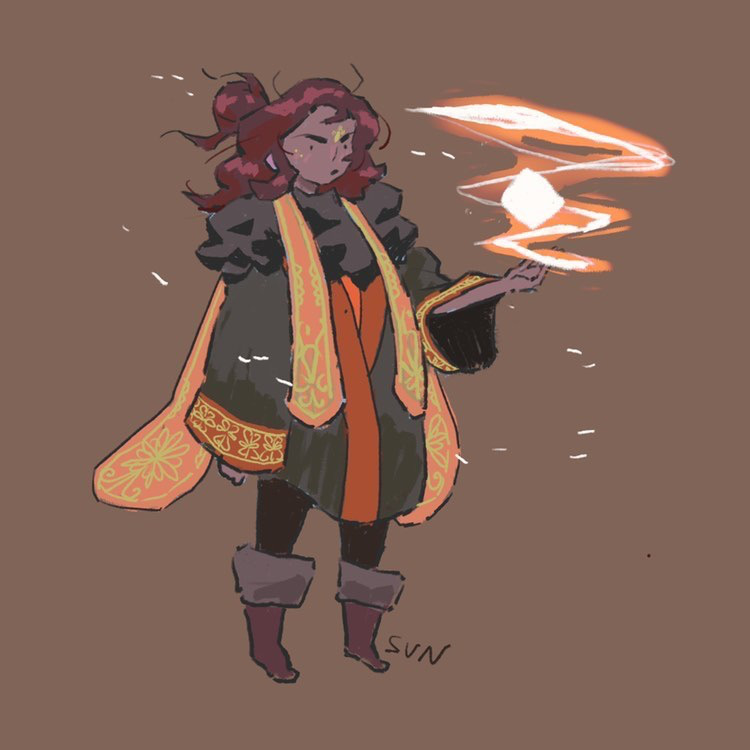Summer Camp Day 15 - Myths, Legends and Folklore
TC's Guide To Mythmaking
How to Write a Myth
There are a few elements I like to keep in mind when writing my myths, things I consider as part of the "magic formula" to give a myth that nice "feels real" touch. In this guide I will do my best to walk you through the elements I enjoy keeping in mind, while also giving a long selection of real world stories I enjoy and that you can look at for inspiration.Background and Culture
A myth reflects the people who tell it. Its themes, symbols, narratives all make sense to them first and foremost. When creating a myth, it can thus be very useful to look at what is around your people. Where do they live? What do they survive off of? Ancient Egyptians relied on cows and bulls a lot, and thus they worshiped sacred cows such as Apis. In some cultures, snakes are a symbol of healing, while in others they are a symbol of fertility and renewal.A few questions to get started: Who are the people who created this myth? What is important to them? What are some objects, animals and places with positive connotations? What about negative ones? What symbols and metaphores would they use?
The Characters
First things first, who are the characters in your myth? Often times myths tell the stories of gods or demi-gods of some sort: Zeus kidnapping Europa, Isis tricking Amon-Râ into revealing his true name, Gilgamesh going on his whole epic. But what if your world doesn't have gods? Your characters could become archetypes- the naive teenager become a noble and mature adult, monsters and talking animals, or even superheroes and figures of the past.A few questions to get started: Who are your characters? Who or what do they represent? What is their goal or their journey? For more tips on writing characters, check out this guide (link here) written by the amazing Dr Emily Vair-Turnbull for the Imaginaerium!
The Story
In our world, myths are stories in which fantastical things happen. Gods and mortals collide, great monsters roam the woods, witches craft potions and spells. Most importantly however, many myths are allegories, which they seek to explain things in your world. Some myths are cosmogonies, explaining the world's creation, others are "coming of age" stories illustrating the passage from childhood to adulthood. You have your love stories (tragic or not), tales of war, journeys to the land of the dead and back- anything goes.A few questions to get started: What things in your world need explaining (time, space, its creation and laws, why flamigoes are pink)? How would your myth explain it?
The Passage of Time
Some myths do not start out as myths. The Illiad and the Odessy were books, and many of the Greek and Roman myths we know today we know through plays and retellings. Charlemagne's reign became part of the Matter of France, a cycle of epic stories detailling the adventures of his knights and of the king himself. A lot of myths take root in real events, grown and distorted into something fantastical through time. As a result, myths will often exist under several iterations.A few questions to get started: What was the original story? How might it have been transformed, and who did it? Did some versions get promoted over others, and why?
Who Tells a Myth, Why and How
A myth is not told on its own, so let us take a look at those who tell them. They could be priests, poets, dramaturges, but they could also be agents of the state or parents passing down tales and stories to their children. Who tells a myth also informs you on why they tell it. Sometimes it just for the beauty of a story, but it could (and often) serves a purpose in propaganda. The deification of generals and kings is a powerful tool in any war. Myths could also be used to pass down knowledge, or to hide secrets in plain sight (à la Da Vinci Code).A few questions to get started: What institution shares the myth? Who has made it famous? Why is it shared, what purpose does it serve? Is there any reason in time which might explain its ressurgence (a new war, the discovery of a new land, a recently overthrown country)?
What's in a Myth?
In the common use sense of the word, a myth refers to a story (generally) featuring gods or god-like characters, doing (generally) extraordinary things such as defeating magical creatures or creating the world. These stories are (generally) old, and (generally) religious. There is a whole academic field worth of discussion over the nature of a myth, but to save us some time I’ll stick to this broad definition. Another note: most of what I say about myths can (and will) be applied to other types of stories, like legends, folktales, fairytales, epics and whatnot.
Selection of Myths
Matter of Britain: The Matter of Britain is the name given to the legends and stories of King Arthur and his Knights. This is an example of a story which acquired mythical status over time, which still holds influence today. Another good example of this is the Matter of France.
Epic of Gilgamesh: the various tales of Mesopotamia’s most famous King, who seeks immortality and travels to the land of the dead and back.
Nu / Noun / Nunet: the primordial waters from which the egyptian god Atum is said to have created the world.
Enchanted Forests: an ever-present trope within many folktales and legends, enchanted forests hold a particular place in our imaginary landscape. They are often a place of wonder, magic and danger.
Beast of Gévaudan: a wolf like monster who terrorised the town of Gévaudan in France circa 1765. The events that transpired inspired many stories and legends, including werewolves!
Minotaur: the half man, half bull monster, son of Minos, and his punishment for having tried to trick a god. Every year the king Minos forces the Athenians to deliver 7 women and 7 men to feed the beast.
Naga Fireballs: Balls of fire can be seen over the Mekong River in Thailand. This mysterious phenomenon is generally attributed to the Naga which lives in the river, and is said to spit the fire itself. The fun thing with this one, is that it only started happening in the last 35 years or so!
Kali and Sainte Sara: The Hindu goddess Kali is worshipped under many forms. One of them could be seen as that of Sainte Sara, also known as "Sara-la-Kali". She is the patron "saint" of catholic Roma, many of which make the pilgramage to the city in South of France where she is venerated. The similarity in names and rituals seem to suggest that Sainte Sara may have evolved from an older worship of Kali.






Great article TC!! I It will certainly help me a A LOT when creating myths for my world. Also your article of the Epic of Lovers is awesome and it really helped a lot for the issue i told you that I have of creating relations between mortals and gods and their relations with the nations that they believe they descend from them. Again, thank you so much!!
Oooh thank you for your really sweet comment :'0 ! I'm really glad this can be of use <3 thank you for reading! And be sure to send me the link of whatever myth you make!
hehe I'll if you are interested in reading them! ;)